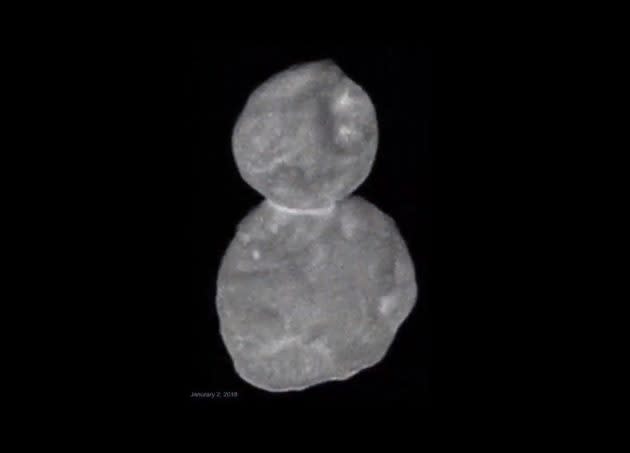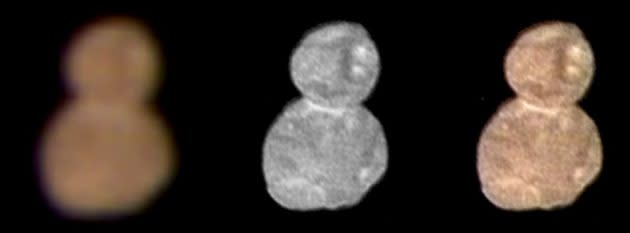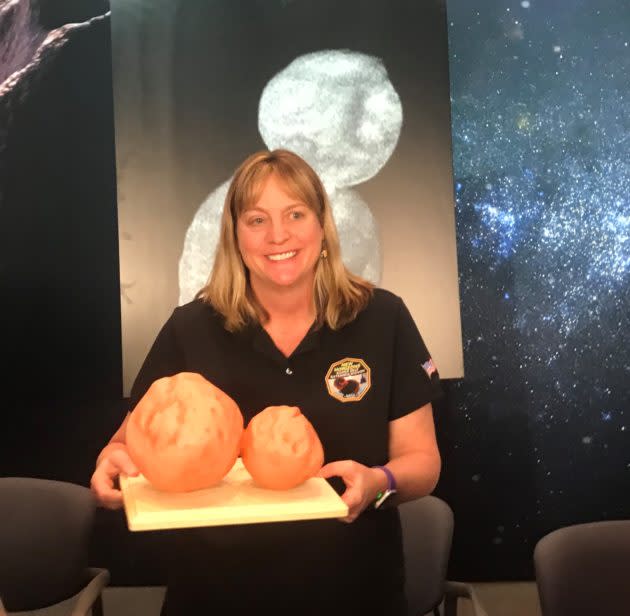NASA’s New Horizons probe reveals the shape of its icy target: ‘It’s a snowman!’

LAUREL, Md. — The New Horizons spacecraft’s picture of an icy object 4 billion miles from Earth became a lot clearer today, and took on a surprisingly familiar shape.
“It’s a snowman,” mission principal investigator Alan Stern, a planetary scientist from the Southwest Research Institute, said during a news briefing here at Johns Hopkins University’s Applied Physics Laboratory.
The two-balled shape reminded others of BB-8, the plucky droid from “Star Wars: The Force Awakens.” It even has a BB-8ish orangish-reddish color theme going on.
Today’s imagery, derived from data sent back to Earth on the previous day, literally casts a whole new light on the 19-mile-long object — which is known by its official designation, 2014 MU69, or by the nickname given by the New Horizons team, Ultima Thule (“Ul-ti-ma Too-lay”).
The views were captured by the piano-sized probe’s high-resolution camera from a distance of roughly 18,000 miles, a half-hour before the time of close approach on New Year’s Day. Two black-and-white pictures were released, with a resolution as fine as 140 meters (460 feet) per pixel.
The Long-Range Reconnaissance Imager, or LORRI, had “28,000 pixels on the target … which way beats six pixels,” Stern joked referring to the fuzzy, bowling-pin picture that was released the day before.
“That image is so 2018. … That bowling pin is gone,” Stern said.
An analysis of the picture showed that Ultima’s brightest spots reflect 13 percent of the light that falls on them, while the darkest spots reflect only 6 percent.
“It’s about as reflective as garden-variety dirt, and it’s illuminated by a sun that’s 1,900 times fainter than it is on a sunny day down on Earth,” Stern said. “So we were basically chasing it down in the dark, at 32,000 miles an hour.”
Another camera captured a color view, revealing that Ultima is definitely red, said Carly Howett, a New Horizons science team member from the Southwest Research Institute.

SwRI’s Cathy Olkin, one of the mission’s deputy project scientists, said the red color could well be due to organic chemicals known as tholins that are coating the surface. Tholins are also behind the reddish color in a crater on the surface of Pluto’s biggest moon, Charon, but scientists say the process behind its deposition on Ultima is likely to be different.
Ultima was chosen as a follow-up object for study, coming after New Horizons’ 2015 flyby of Pluto and its moons. Stern said the thing that was most surprising about the experience was “picking a Kuiper Belt object out of a hat” and then finding out that the team had picked a winner.
The new images show Ultima to be a contact binary, consisting of two separate masses that became stuck together. The larger, 12-mile-wide mass has been nicknamed “Ultima.” The smaller, 9-mile-wide mass was given the nickname “Thule.”
Those two balls probably coalesced from primordial icy material in a cold zone known as the Kuiper Belt, perhaps millions or even hundreds of thousands of years after the solar system’s birth more than 4.5 billion years ago, said Jeff Moore, a New Horizons team member from NASA’s Ames Research Center. Then the balls would have been gently drawn together by their mutual gravitational attraction, he said.
Ultima’s current rotation rate, estimated at about 15 hours for a complete turn, isn’t fast enough to fling the two balls apart, Moore said.
Moore said “we’re basically looking at the first planetesimals,” which served as building blocks for what would eventually become planets.
“We should think of New Horizons as a time machine, a wayback machine to time zero,” Moore said. “That has brought us back to the very beginning of solar system history, to a place where we can observe the most primordial building blocks of the planets.”
The flow of images and scientific insights is expected to get stronger in the days, weeks and months ahead, as the spacecraft sends back several gigabytes of stored data at a rate of 1,000 bits per second. “We have far less than 1 percent of the data … already down on the ground,” Stern said.
Another round of imagery and data was received today and will be the focus of a news conference on Thursday.
During the run-up to today’s news conference, a buzz broke out on Twitter over the fact that the term “Ultima Thule,” which in ancient times denoted a place beyond the known world, became a part of Nazi mythology.
In response to a reporter’s question, Stern addressed the controversy head-on. He said Ultima Thule was selected as 2014 MU69’s informal nickname because its ancient meaning provided a “wonderful meme for exploration.”
“Just because some bad guys once liked that term, we’re not going to let ’em hijack it,” Stern said. The comment was greeted with applause by New Horizon team members and their supporters.
After the news conference, Stern told GeekWire that Ultima Thule and other nicknames relating to 2014 MU69’s features would give way to formal names to be approved by the International Astronomical Union, but it’s too early to say which names would be submitted to the IAU by the New Horizons discovery team. That process is likely to unfold over the next year, Stern said.
It’ll take another 20 months to download all the data from the Ultima flyby. Stern said the New Horizons team would start writing scientific papers next week, based on the data already in hand, and almost certainly propose another mission extension to NASA by 2020. “If that proposal is accepted, we would start a search for [another] object that we could fly by,” Stern said.
The plutonium-powered probe should be capable of flying through the Kuiper Belt for another 10 years. “There’s plenty of time to find other targets if we’re in a position to having a still-healthy spacecraft, an accepted proposal, and our search is successful,” Stern said. “So stay tuned.”

More from GeekWire:
New Horizons probe delivers 3-D views of cosmic snowman, plus mysteries to solve
New Horizons team gets first fuzzy glimpse of elongated icy world on solar system’s edge
NASA’s New Horizons probe wakes up from its robotic slumber for post-Pluto flyby
3.8 billion miles! New Horizons spacecraft sends pictures from farthest vantage point
